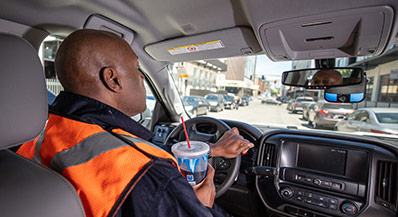Lytx Shares New Insights on Risky Driving Trends Among Field Service Fleets

- Lytx field service clients reduced instances of unsafe following distance by 46%, and unbelted drivers by 19%, from 2018 to 2019
- Drivers of field service vehicles were involved in 26% fewer posted-speed violations than drivers in any other industry
SAN DIEGO — May 7, 2020 — From its unmatched database of 358,000 risky driving events captured from field service fleets in 2019, Lytx® today released new insights into driving trends in the field service industry.
Lytx’s findings include the five risky behaviors seen most often among field service drivers, most improved driving behaviors, and insights on how driving habits in the field service industry compare to those in other industries.
This data was captured from fleets of all sizes and types within the field service industry, including heating, ventilation, and air conditioning (HVAC), contracting, plumbing, electrical, pest control, landscaping, cleaning, and more. It is part of an ongoing series from Lytx highlighting key behavior trends seen across the nine industries that utilize Lytx video telematics technology, with the goal of informing and supporting ongoing safety efforts in the industries it serves.
The data will be released twice weekly through May 21 here: https://www.lytx.com/en-us/industry-benchmark-data.
Most Prevalent Risky Behaviors in 2019
- Failure to stop**
- Late response***
- Food/drink observed
- Following distance*
- Cell phone observed
Most Improved Behaviors From 2018 to 2019
- Following distance* – improved 46%
- Posted-speed violation – improved 22%
- Driver unbelted – improved 19%
- Failure to stop** – improved 10%
Behaviors may appear on both the "Most Prevalent" and "Most Improved" lists. This demonstrates that even with significant improvement, fleets and drivers must stay vigilant and maintain awareness to keep those behaviors trending downwards.
How Field Service Fleets Stack Up Against Other Industries
Lytx compared the prevalence of behaviors seen in field service fleets against behavior averages of fleets across all its other protected industries. Comparatively, field service fleets stood out in the following areas:
- Posted-speed violation, which occurred 26% less often
- Cell phone observed, which occurred 17% more often
Common risky driving behaviors observed within a fleet, as well as benchmarking data from fleets both inside and outside of a specific industry are helpful metrics for understanding industry-specific challenges, guiding safety efforts and then measuring success. To better identify and address top areas of driving risk within their individual fleets, thousands of organizations use the best-in-class Lytx Driver Safety Program; these organizations experience on average up to 50% reduction in collisions and up to 80% on associated claims costs as a result.
Field Service Collision Insight
Lytx also found that 62% of collisions in the field service segment were rear-end or backing-related occurrences. Even at low speeds, rear-end collisions can lead to costly litigation. Two key ways to reduce rear-end collision potential are maintaining a safe following distance and eliminating in-cab distractions, such as cell phone use.
About the Data
These insights were derived from Lytx’s proprietary database of field service driving data from 2019, including 358,000 risky field service driving events captured last year. For comparisons across industries, Lytx calculated behavior averages from its global database, which contains driving data from trucking, distribution, concrete, construction, utilities, transit, government, and waste industries. Lytx maintains the fastest-growing proprietary database of professional driving data in the world, currently surpassing 120 billion miles of driving data. The data is anonymized, normalized, and in instances of behavior prevalence, generalizable to service fleets at large.
About Lytx
Lytx® is a leading provider of video telematics, analytics, safety, and productivity solutions for commercial, public sector, and field service fleets. Our unrivaled Driver Safety Program, powered by our best-in-class DriveCam® Event Recorder, is proven to help save lives and reduce risk. We harness the power of video to help clients see what happened in the past, manage their operations more efficiently in the present, and improve driver behavior to change the future. Our customizable service and programs span driver safety, risk detection, fleet tracking, compliance, and fuel management. Using the world’s largest driving database of its kind, along with proprietary machine vision and artificial intelligence technology, we help protect and connect thousands of fleets and more than 1.3 million drivers worldwide. For more information on Lytx telematics system, visit http://www.lytx.com, @lytx on Twitter, LinkedIn, our Facebook page or our YouTube channel.
*Following distance refers to a risky driving event in which the distance to the vehicle directly ahead is approximately 1.5 seconds and not increasing for at least 4 consecutive seconds.
**Failure to stop occurs when a driver fails to stop at a stop sign or his/her speed remains above 5 mph.
***Late response occurs when a driver is not distracted yet responded late and abruptly to a readily visible risky situation ahead.
# # #
